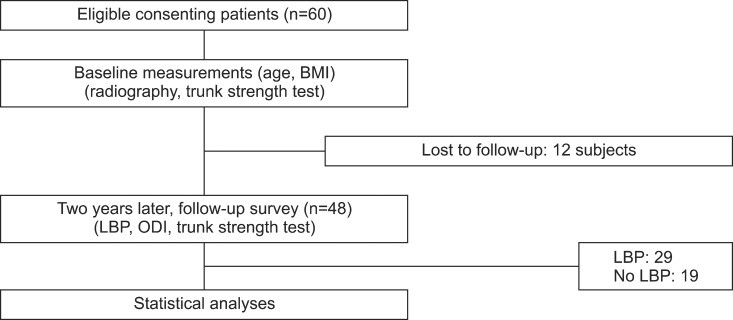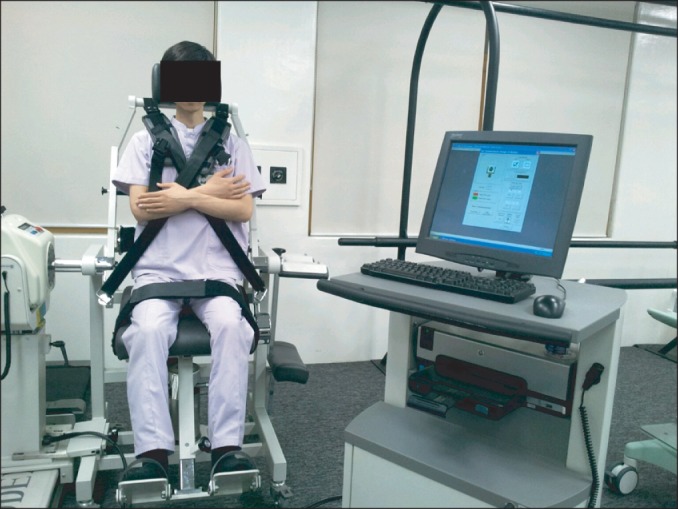Ann Rehabil Med.
2014 Apr;38(2):234-240.
Trunk Muscles Strength as a Risk Factor for Nonspecific Low Back Pain: A Pilot Study
- Affiliations
-
- 1Department of Rehabilitation Medicine, Chungnam National University School of Medicine, Daejeon, Korea. ljh2434@cnuh.co.kr
- 2Department of Rehabilitation Medicine, Yuseong Wellness Rehabilitation Hospital, Daejeon, Korea.
Abstract
OBJECTIVE
To investigate the effects of asymptomatic back muscle weakness and spinal deformity on low back pain (LBP).
METHODS
Sixty healthy subjects without LBP participated in this study. Radiography and an isokinetic/isometric dynamometer were used to respectively measure spinal scoliosis/lordosis and the strength of the trunk flexors/extensors. After 2 years, 48 subjects visited the hospital again and LBP episodes, its severity and the Korean version of the Oswestry Disability Index were assessed. Differences between the group with LBP and the group without LBP were evaluated and the association with LBP incidence and severity was determined.
RESULTS
Sex, age, and trunk strength were significantly different in both group. Sex and age were significantly positive associated with LBP incidence. The isometric trunk flexor and extensor strength, maximum isokinetic trunk flexor and extensor strength were significantly and negatively associated with the LBP severity. The maximum isokinetic trunk extensor and maximum isometric trunk extensor strength was significantly negative associated with the LBP incidence.
CONCLUSION
LBP incidence is associated with isometric and isokinetic trunk extensor weakness, whereas LBP severity is associated with age, sex, isokinetic trunk extensor and flexor weakness, isometric trunk extensor and flexor weakness.
Keyword
MeSH Terms
Figure
Reference
-
1. Walsh K, Cruddas M, Coggon D. Low back pain in eight areas of Britain. J Epidemiol Community Health. 1992; 46:227–230. PMID: 1386619.
Article2. Pengel LH, Herbert RD, Maher CG, Refshauge KM. Acute low back pain: systematic review of its prognosis. BMJ. 2003; 327:323. PMID: 12907487.
Article3. Andersson GB. Epidemiological features of chronic low-back pain. Lancet. 1999; 354:581–585. PMID: 10470716.
Article4. van den Hoogen HJ, Koes BW, van Eijk JT, Bouter LM, Deville W. On the course of low back pain in general practice: a one year follow up study. Ann Rheum Dis. 1998; 57:13–19. PMID: 9536816.
Article5. Linton SJ, van Tulder MW. Preventive interventions for back and neck pain problems: what is the evidence? Spine (Phila Pa 1976). 2001; 26:778–787. PMID: 11295900.6. Park YJ, Choi KS, Lee SG. Effect of lumbar extensor strengthening in chronic low back pain patients. J Korean Acad Rehabil Med. 2000; 24:295–300.7. Kim KY. Clinico-radiologic findings of the whole spine in patients with chronic low back pain. J Korean Acad Rehabil Med. 2000; 24:137–145.8. Vaz G, Roussouly P, Berthonnaud E, Dimnet J. Sagittal morphology and equilibrium of pelvis and spine. Eur Spine J. 2002; 11:80–87. PMID: 11931071.
Article9. Jeon CH, Kim DJ, Kim SK, Kim DJ, Lee HM, Park HJ. Validation in the cross-cultural adaptation of the Korean version of the Oswestry Disability Index. J Korean Med Sci. 2006; 21:1092–1097. PMID: 17179693.
Article10. George SZ, Childs JD, Teyhen DS, Wu SS, Wright AC, Dugan JL, et al. Predictors of occurrence and severity of first time low back pain episodes: findings from a military inception cohort. PLoS One. 2012; 7:e30597. PMID: 22355317.
Article11. Bejia I, Younes M, Jamila HB, Khalfallah T, Ben Salem K, Touzi M, et al. Prevalence and factors associated to low back pain among hospital staff. Joint Bone Spine. 2005; 72:254–259. PMID: 15850998.
Article12. Evans K, Refshauge KM, Adams R, Aliprandi L. Predictors of low back pain in young elite golfers: a preliminary study. Phys Ther Sport. 2005; 6:122–130.
Article13. Burdorf A, Jansen JP. Predicting the long term course of low back pain and its consequences for sickness absence and associated work disability. Occup Environ Med. 2006; 63:522–529. PMID: 16849528.
Article14. Chon J, Kim SW, Kim SS, Kim YG, Choi HJ, Ahn KH, et al. Risk factors of low back pain in a general population. J Korean Acad Rehabil Med. 2000; 24:981–987.15. Egger GJ, Vogels N, Westerterp KR. Estimating historical changes in physical activity levels. Med J Aust. 2001; 175:635–636. PMID: 11837872.
Article16. Nachemson A. The load on lumbar disks in different positions of the body. Clin Orthop Relat Res. 1966; 45:107–122. PMID: 5937361.
Article17. Hedman TP, Fernie GR. Mechanical response of the lumbar spine to seated postural loads. Spine (Phila Pa 1976). 1997; 22:734–743. PMID: 9106313.
Article18. Pope MH, Goh KL, Magnusson ML. Spine ergonomics. Annu Rev Biomed Eng. 2002; 4:49–68. PMID: 12117750.
Article19. Liuke M, Solovieva S, Lamminen A, Luoma K, Leino-Arjas P, Luukkonen R, et al. Disc degeneration of the lumbar spine in relation to overweight. Int J Obes (Lond). 2005; 29:903–908. PMID: 15917859.
Article20. Leboeuf-Yde C. Body weight and low back pain: a systematic literature review of 56 journal articles reporting on 65 epidemiologic studies. Spine (Phila Pa 1976). 2000; 25:226–237. PMID: 10685488.21. Jackson RP, Simmons EH, Stripinis D. Incidence and severity of back pain in adult idiopathic scoliosis. Spine (Phila Pa 1976). 1983; 8:749–756. PMID: 6229884.
Article22. Gremeaux V, Casillas JM, Fabbro-Peray P, Pelissier J, Herisson C, Perennou D. Analysis of low back pain in adults with scoliosis. Spine (Phila Pa 1976). 2008; 33:402–405. PMID: 18277872.
Article23. Alaranta H, Luoto S, Heliovaara M, Hurri H. Static back endurance and the risk of low-back pain. Clin Biomech (Bristol, Avon). 1995; 10:323–324.24. Han TR, Kim JH, Chung SG, Kwon BS, Lee KW. Correlation of ultrasonographic measure of lumbar multifidus muscles with isometric torque of low back. J Korean Acad Rehabil Med. 1999; 23:809–814.25. Brukner P, Khan K. Clinical sports medicine. 3rd rev. ed. Sydney: McGraw-Hill;2010.26. Bigos SJ, Holland J, Holland C, Webster JS, Battie M, Malmgren JA. High-quality controlled trials on preventing episodes of back problems: systematic literature review in working-age adults. Spine J. 2009; 9:147–168. PMID: 19185272.
Article27. Hides JA, Jull GA, Richardson CA. Long-term effects of specific stabilizing exercises for first-episode low back pain. Spine (Phila Pa 1976). 2001; 26:E243–E248. PMID: 11389408.
Article28. Barr KP, Griggs M, Cadby T. Lumbar stabilization: a review of core concepts and current literature, part 2. Am J Phys Med Rehabil. 2007; 86:72–80. PMID: 17304690.
- Full Text Links
- Actions
-
Cited
- CITED
-
- Close
- Share
- Similar articles
-
- Concentric and Eccentric Isokinetic Trunk Muscle Evaluation in Chronic Low Back Pain
- The Effect of Chronic Low Back Pain on Bone Mineral Density and Trunk Muscle Strength in Women
- Effects of Sling Exercise on Pain, Trunk Strength, and Balance in Patients with Chronic Low Back Pain
- Efficacy and Safety of Abdominal Trunk Muscle Strengthening Using an Innovative Device in Elderly Patients With Chronic Low Back Pain: A Pilot Study
- The Relationship between Cross Sectional Area and Strength of Back Muscles in Patients with Chronic Low Back Pain



